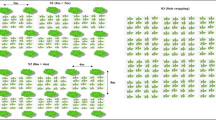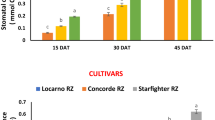Abstract
Three promising genotypes (CAZRI 75, CAZRI 2178 and CAZRI 2221) of buffel grass (Cenchrus ciliaris L.) were evaluated for maximization of seed production by imposing different cutting management practices, i.e. uncut (control), single cut at 30 and 45 days of sowing/regeneration and at 50 % flowering during 2010–2013 under arid conditions of Thar desert. Maximum pure seed yield (PSY) of 67.6 kg/ha was produced by CAZRI 2221 in 2011, 53.5 kg/ha in 2012 and 72.0 kg/ha in 2013 with average of 64.4 kg/ha, which was 131.7 and 32.2 % higher than CAZRI 75 and CAZRI 2178, respectively. Highest PSYs were obtained from uncut crop in all the years, and average over the last 3 years showed that the PSY (86.3 kg/ha) from uncut treatment was 117.4, 283.6 and 119.0 % higher than the crops cut at 30 and 45 days and 50 % flowering, respectively. Average over the last 3 years of crop growth also showed that plant height, number of fertile tillers/meter row length, spike length, 1,000-seed weight, seeds/spike, seed weight/spike and dry matter yield were maximum with no cutting. Reduced dry matter yield was recorded in the years 2012 and 2013 when cuttings were imposed. The findings of the investigation showed that CAZRI 2221 was the best seed yielder and higher seed yields were obtained from the uncut treatment.



Similar content being viewed by others
References
Dabadghao PM, Shankarnarayan KA (1973) The grass cover of India. Indian Council of Agricultural Research, New Delhi p 713
Lin KHR, Tsou CC, Hwang SY, Chen LF, Lo HF (2006) Paclobutrazole pretreatment enhanced flooding tolerance of sweet potato. J Plant Physiol 7:750–760
Bahrani MJ, Bahrami H, Haghighi AAK (2010) Effect of water stress on ten forage grasses native or introduced to Iran. Grassl Sci 56:1–5
Samarah N, Mullen R, Cianzio S (2004) Size distribution and mineral nutrients of soybean seeds in response to drought stress. J Plant Nutr 27(5):815–835
Akram NA, Shahbaz M, Ashraf M (2008) Nutrient acquisition in differentially adapted populations of Cynodon dactylon (L.) Pers. and Cenchrus ciliaris L. under drought stress. Pak J Bot 40(4):1433–1440
Sawal RK, Ratan R, Chander S (2009) Nutritive evaluation of Lasiurus sindicus and Cenchrus ciliaris hays in sheep. Indian J Small Rumin 15(2):277–280
Khan S, Hussain A, Muhammad NS, Imran M (2004) Effects of nitrogen fertilizer on forage yield on buffelgrass. Sarhad J Agric 20:425–428
Mansoor U, Hameed M, Wahid A, Rao AR (2002) Ecotypic variability for drought resistance in Cenchrus ciliaris L. germplasm from Cholistan desert in Pakistan. Int J Agr Biol 4(3):392–397
Singh RP, Hazra CR (1995) Forage seed production-status and strategy. In: Singh RP (ed) Forage production and utilization. Indian Grassland and Fodder Research Institute, Jhansi, pp 309–325
Chapman CR (1996) The biology of grasses. CAB Int, Walingford
Wilson JR (1983) Effects of water stress on herbage quality. Westview Press, Boulder, pp 470–472
Humphreys LR, Riveros F (1986) Tropical pasture seed production, 3rd edn. FAO plant production and protection paper 8, Rome
López-Chukenl J Ulrico, López-Domínguez Ulrico (2012) Effect of fertilization, intensity, frequency and season of defoliation on herbage yield and nutritive value of Cenchrus ciliaris L. Range Manag Agrofor 33(2):157–161
Purushotham S, Siddaraju R, Narayanswamy GV (2001) Effect of cutting and nitrogen management in promising varieties of guinea grass for fodder-cum-seed purposes. Karnataka J Agril Sci 14(2):295–298
Kumar D, Seth R, Natarajan S, Dwivedi GK, Shivay YS (2008) Seed yield response of marvel grass (Dichanthium annulatum) to cutting management and nitrogen fertilization in central India. Agron Res 6(2):499–509
Dwivedi GK, Kumar D, Tomer PS (1999) Effect of cutting management and nitrogen levels on growth, seed yield attributes and seed production of Setaria sphacelata cv. Nandi. Trop Grassl 33:146–149
Abuelgasim AK, Abusuwar AO (2001) ) Effect of sowing methods, seeding rates and cutting management on seed yield of alfalfa (Medicago sativa L.). Int J Sci Nat 2(3):570–574
Narwal SS, Sardana V (2001) Fodder and seed yields as influenced by row spacing and cutting management of component crops in berseem based intercropping systems. Indian J Agric Sci 71(3):159–162
Gaetano A, Giambalvo D, Ruisi P (2013) Cut and post-cut herbage management affects berseem clover seed yield. Agronomy J 4:1222–1230
Guha S, Sharangi AB, Debnath S (2013) Effect of different sowing times and cutting management on phenology and yield of off season coriander under protected cultivation. Trends Hortic Res 3:27–32
ISTA (2004) International rules for seed testing, edition 2004. The International Seed Testing Association (ISTA), Bassersdorf
Gomez KA, Gomez AA (1984) Statistical procedures for agricultural research, 2nd edn. Wiley, New York p 680
Rajora MP, Singh M (2005) Seed yield and its components in winter regenerated flush of buffel grass (Cenchrus ciliaris Linn.) under rainfed conditions of Rajasthan. Seed Res 33(1):65–69
Rajora MP (1998) Variability and character association in buffel grass. Ann Arid Zone 37(1):99–101
Chander S, Sharma KC, Jat HS, Meena RP (2009) Influence of varieties and cutting schedules of perennial pasture grasses on soil fertility, nutrients content and uptake, productivity and economics in hot arid conditions of Rajasthan. Indian J Agric Sci 79(10):798–803
Bhatt RK, Tripathi RK, Tiwari HS (2009) Effect of cutting management on seed yield and its quality in grasses. Seed Res 37(1 & 2):26–29
Kizima JB, Mtengeti EJ, Nchimbi-Msolla S (2014) Seed yield and vegetation characteristics of Cenchrus ciliaris as influenced by fertilizer levels, row spacing, cutting height and season. Livest Res Rural Dev 26(8): article #148
Norman MJT (1960) Performance of buffel grass and buffel grass-Townsville lucerne mixtures at Katherine, N. T. CSIRO. Australia. Technical Paper No 11. Division of Land Research and Regional Survey
Acknowledgments
The authors acknowledge the Directorate of Seed Research, Mau, India for providing funds for the study under Seed Technology Research (AICRP, National Seed Project-Crops).
Conflict of interest
None.
Author information
Authors and Affiliations
Corresponding author
Rights and permissions
About this article
Cite this article
Rajora, M.P., Mahajan, S.S., Bhatt, R.K. et al. Response of Genotypes to Cutting Management for Seed Yield in Cenchrus ciliaris Under Hot Arid Conditions. Proc. Natl. Acad. Sci., India, Sect. B Biol. Sci. 86, 455–462 (2016). https://doi.org/10.1007/s40011-014-0467-8
Received:
Revised:
Accepted:
Published:
Issue Date:
DOI: https://doi.org/10.1007/s40011-014-0467-8




